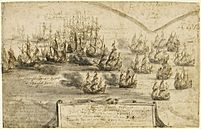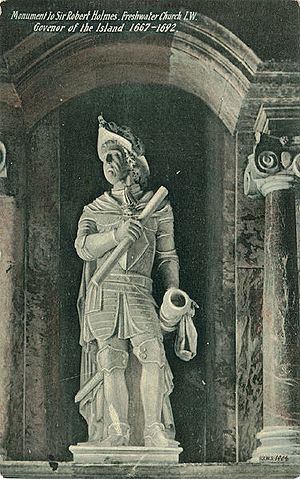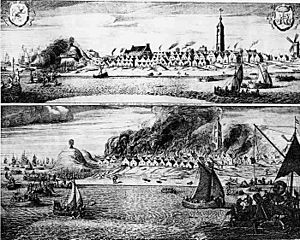Robert Holmes (Royal Navy officer) facts for kids
Quick facts for kids
Admiral
Sir Robert Holmes
|
|
|---|---|

Sir Frescheville Holles (on left) and Sir Robert Holmes (on right), painted by Peter Lely
|
|
| Governor of the Isle of Wight | |
| In office 1668–1692 |
|
| Monarch | Charles II James II & VII William III & II and Mary II |
| Preceded by | The Lord Colepeper |
| Succeeded by | Hon. Thomas Tollemache |
| Vice-Admiral of Hampshire | |
| In office 1669–1692 |
|
| Preceded by | The Lord Colepeper |
| Succeeded by | Marquess of Winchester |
| Member of Parliament for Yarmouth | |
| In office 1689–1690 Serving with Hon. Fitton Gerard
|
|
| Monarch | Charles II |
| Preceded by | Thomas Wyndham William Hewer |
| Succeeded by | Sir John Trevor Charles Duncombe |
| Personal details | |
| Born | 1622 |
| Died | 18 November 1692 (aged 69–70) |
| Nationality | British |
| Children | Mary Holmes |
| Parent | Henry Holmes |
| Relatives | Sir John Holmes (brother) Henry Holmes (nephew) Thomas Holmes (grandson) Henry Holmes (grandson) Charles Holmes (grandson) |
| Military career | |
| Allegiance | |
| Service/ |
|
| Years of service | 1643–1687 |
| Rank | Captain (Army) Admiral (Navy) |
| Commands held | Royal Charles HMS Reserve HMS Revenge |
Sir Robert Holmes (around 1622 – 18 November 1692) was an English Admiral who served in the Restoration Navy. He took part in the second and third Anglo-Dutch Wars. Some people even say he helped start these wars. He became the Governor of the Isle of Wight, where he is buried in Yarmouth Parish Church.
Holmes is best known for his adventures on a trip to Guinea in 1664 for the Royal African Company. He is also famous for an event called Holmes's Bonfire in 1666. He is seen as a classic example of a naval officer from that time.
Contents
Early Life and Military Career
Joining the Army
Robert Holmes was born around 1622 in Mallow, Ireland. We don't know much about his early life. However, his excellent writing skills suggest he had a good education. He likely was the grandson of Robert Holmes, who was a leader in Mallow in 1612.
Holmes first appeared in 1643 during the English Civil War. He fought on the side of the King, known as the Cavaliers. He was a junior officer in Prince Maurice's cavalry group. This is where he became lifelong friends with Maurice's brother, Prince Rupert. Holmes joined Rupert on battlefields in Europe after the Royalists lost the Civil War.
In 1648, some of the English fleet joined the exiled King. Holmes, who was an army captain by then, followed Prince Maurice and Prince Rupert. This was his first experience with the navy. He joined a long voyage of the Royalist fleet from 1649 to 1652. They sailed to Kinsale, the Mediterranean, West Africa, and the West Indies.
Many sailors were lost due to storms, battles, and mutinies. By the end of the trip, Holmes was in charge of four captured ships that they brought back to France. When Rupert returned to the King's court, Holmes was responsible for paying off the fleet.
After this, it was reported that Holmes got permission from the King of Spain to be a privateer. A privateer was like a legal pirate who attacked enemy ships. However, there is no other proof that he actually became one. He might have joined the Imperial army, like other Royalist officers. His tombstone in Yarmouth says he fought in France, Flanders, and Germany. Just before King Charles II returned to England, Holmes worked as a messenger between the King and Edward Montagu. Montagu then gave Holmes his first command in the navy, a guardship called Bramble.
Serving the King
Rewards and New Roles
When King Charles II returned to England, Holmes was rewarded for his loyalty. He was made captain of Sandown Castle, Isle of Wight. He also received a new command from the Duke of York, who was the head of the navy. This was just the beginning for Holmes.
First Trip to Africa
Prince Rupert had told stories about a "Mountain of Gold" in Gambia. This made the Royal African Company, led by the Duke of York, want to send an expedition to the Guinea Coast. This area was mostly controlled by the Dutch at the time. Holmes knew this coast well, so he was chosen to lead the mission. He was captain of the main ship, Henrietta, and four other King's ships. His orders were to help the company and build a fort. He was also secretly told to find out more about the "Mountain of Gold."
The trip had mixed results. At Gorée, Holmes told the Dutch governor that the King of England had the only right to trade and sail in that area. The King and Sir George Downing later said this was not true after the Dutch complained. Holmes explored the coast and the Gambia River. He built a fort on Dog Island (renamed Charles Island). Upriver, he captured a fort on St. Andreas Island, which was controlled by the Dutch. He renamed it James Island.
The mission did not make much money for the company. But Holmes seemed to have profited from it. Samuel Pepys, a famous diarist, even complained about Holmes's fancy lifestyle. He also wondered if a large ape Holmes brought back could be taught things.
This expedition was a turning point for Holmes. He showed he could handle different groups of people, including Africans, company workers, the Dutch, and his own crew. He proved to be a careful and smart leader. Because of this, he was made captain of the main ship, Royal Charles. He lost this command quickly after failing to make the Swedish ambassador salute the English flag. But this was only a small setback. He soon received money from the King and command of the new ship, Reserve. On Reserve, Holmes tested new pendulum watches designed by Christiaan Huygens.
Second Trip to Africa
The goals of the famous 1664 Guinea expedition are not fully clear. Holmes was accused of going beyond his orders by capturing Dutch forts and ships. However, some believed this was a planned move to start a war with the Dutch. Holmes's orders were to help the Royal Company and to "kill, take, sink or destroy" anyone who opposed him. This especially included a Dutch ship called Goulden Lyon.
Holmes's success was greater than expected, so he became a convenient scapegoat for the government. He seemed to know this. Near the Dutch base at Gorée, he captured the ship Brill on December 27, 1663. He then attacked Gorée, sinking two ships and capturing two others on January 22, 1664. The next day, he took control of the fort itself. On March 28, he cleverly captured Goulden Lyon, which was renamed Walcheren and joined the Royal Navy.
On April 10, he captured Anta Castle on the Gold Coast and other small forts and ships. But his biggest success was taking Cape Coast Castle near El Mina on May 1. This was the main Dutch base in West Africa. Holmes was not involved in the capture of New Amsterdam.
In August, the Dutch admiral Michiel de Ruyter was secretly sent to undo Holmes's work. De Ruyter recaptured everything Holmes had taken, except for Cape Coast Castle. This meant that after 1664, the English stayed on that coast.
When Holmes returned to England, he tried to understand the reaction to his actions. Since he commanded navy ships, everything he captured was not automatically the company's property. It had to be approved by courts as prizes for Holmes and his men. Holmes's captured goods were less than the company expected. He was sent to the Tower twice in early 1665. There, he was questioned by government officials. This situation was resolved when the Dutch declared on February 22 that they would attack British ships. This was a direct result of the events in Africa, and the British saw it as a declaration of war.
The Second Dutch War
Just a month after being released, Holmes took command of HMS Revenge, a powerful ship with 58 guns. He was a senior captain in Prince Rupert's squadron. At the battle of Lowestoft (June 3, 1665), a senior officer was killed. Holmes wanted his position, and Rupert agreed. But the Duke of York gave the position to his own captain. Holmes became angry and quit.
However, he was soon back in favor. On March 27, 1666, a new ship, Defiance, was launched. King Charles II, the Duke of York, and Prince Rupert were there. Holmes was made captain and was knighted. Holmes was finally given a temporary high rank when the fleet was split up. This put him above another officer, which was satisfying for him.
During the terrible Four Days Battle, Holmes was said to have "done wonders." He was confirmed in his high rank. His ship was so damaged that he moved his flag to another ship, the Henry. But other officers were promoted above him again. These rivalries were common in the navy at the time. Holmes used a later battle, the St James' Day Fight, to argue with another officer whose squadron had been defeated. These arguments between officers played a role in a later investigation by Parliament.
On August 9, 1666, Holmes achieved his most famous feat. He used his own judgment to interpret his orders, which often annoyed others. Holmes was supposed to land men on two islands, Vlieland and Terschelling, to loot and destroy. Instead, Holmes used fireships to attack many merchant ships in Vlie Road. He destroyed about 150 ships and sacked the town of West-Terschelling.
This event, called Holmes's Bonfire, was the biggest blow the English dealt to Dutch merchant shipping. It seriously hurt the Netherlands' war effort. It cost the English only twelve casualties. Holmes was now very popular. In early 1667, he was given command of a squadron based in Portsmouth and the Isle of Wight. This was a good position that even allowed him to use one of the captured ships as a privateer. In April 1667, he became a captain in the army, but he left this role before 1670.
By December 1666, Pepys had noted Holmes's strong opposition to putting the fleet away, expecting peace. Holmes was aware of the danger of a Dutch attack. This attack happened on June 10, 1667, during the Raid on the Medway. Michiel de Ruyter entered the Medway River, burned many English ships, and captured Royal Charles.
After that year's fighting ended, Parliament became more interested in how the navy was run. Many naval officers, especially those from noble families, were unhappy with how they were treated by the administrators. The administrators, in turn, found the officers arrogant and difficult. Now, the commanders and their friends, like Sir Frescheville Holles and Holmes, could fight back, especially after the Medway disaster.
Holmes also restarted his argument with Sir Jeremiah Smith in the winter of 1666/1667. This argument only ended when Smith took a position on the Navy Board in December 1668, a position Holmes had hoped to get.
After peace was made, Holmes strengthened his power in the Isle of Wight. He bought the governorship from Lord Colepeper. This made him responsible for the defenses there, including Sandown, Carisbrooke, and Yarmouth Castles. It also gave him access to the very profitable role of vice-admiral of the Isle of Wight and Hampshire. This meant he received two-thirds of the value of all captured ships in that area.
In October 1669, he was also elected to Parliament for Winchester. He generally supported the King in Parliament.
The Third Dutch War

As preparations were made to start another war with the Dutch, Holmes was appointed senior officer in Portsmouth. He commanded a strong squadron and the flagship St Michael, a large ship with 90 guns. Holmes immediately pushed to capture many Dutch ships that were using English harbors. But the government waited too long, and the chance was lost.
On March 23, 1672, he finally got permission to attack the Dutch Smyrna convoy, which was returning home. For two days, the English squadron fought a real battle with the armed merchant ships and their escorts. The English suffered a lot of damage but gained only about half a dozen captured ships. Only one of these seemed to be a rich Smyrna ship. Another English squadron, returning from the Mediterranean, had passed by just before the fight. For unknown reasons, they did not join the attack, which led to new suspicions between the officers. A few days after the fight, war was declared. Holmes did not receive a high rank, possibly because the French fleet was part of the English forces this time. So, Holmes fought in the Battle of Solebay as just a captain in the Duke of York's squadron. This battle was one of the fiercest in De Ruyter's memory. Holmes's friends Holles and Sandwich were killed. The Duke of York had to move his flag to different ships during the battle, including Holmes's St Michael. With Sandwich dead, a new high-ranking officer was needed. But Holmes's rightful claims were ignored again.
After the 1672 campaign ended, Holmes did not get another command. Even though his friend Prince Rupert, the new commander-in-chief, constantly spoke up for him, the King clearly did not want to use him anymore. Holmes's naval career ended very suddenly.
Later Life and Legacy
Even though the King would not let Holmes serve in his fleet anymore, he continued to give him gifts. Holmes received money from lands in Southampton, the Isle of Wight, and Wales. He also got lands that had been taken from others in Galway and Mayo, Ireland. He owned houses in London, Englefield Green, Bath, and a grand home in Yarmouth as governor.
During his "retirement," Holmes spent most of his time rebuilding the Isle of Wight's castles. He also managed parliamentary elections to make sure government candidates were chosen. He did not run for Parliament himself between 1679 and 1681. In 1682, he angered King Charles II by supporting the Duke of Monmouth. A court hearing was prepared, and there was a plan to give his governorship to someone else. But Holmes either avoided the charges or proved himself innocent, because he remained governor until his death.
Holmes was a strong supporter of the royal brothers, King Charles II and King James II. It's not clear why he would have associated with Monmouth. This might have involved a financier named Lemuel Kingdon, who was a Member of Parliament with Holmes's brother, John.

On August 21, 1687, Holmes was given command of a squadron to stop buccaneers (pirates) in the West Indies. But it is doubtful if he ever actually took command. His health was getting worse after a wound he received during the clash with the Smyrna Convoy. Another officer commanded the expedition instead. Holmes was then busy preparing defenses against a Dutch invasion. On November 4, 1688, five sailors from the invasion fleet landed on the Isle of Wight to buy supplies. The local people welcomed them.
While the English fleet was stuck off Beachy Head and William III landed his forces at Torbay, Holmes struggled with his rebellious local soldiers. King James II fled his capital on December 11. Parliament saw this as him giving up the throne. The next day, the commander-in-chief brought the fleet over to William. But it was not until December 17 that Holmes surrendered.
He continued as governor of the Isle of Wight. Sometimes, he was suspected of secretly supporting the old King James II. But any doubts he had about King James II being overthrown came from his loyalty as a military professional. After his vote in Parliament against William and Mary becoming rulers was defeated, he served them with the same dedication he had shown the Stuart kings. Although his health was rapidly failing, and he had to spend more time in Bath, the threat of French invasions in 1690 and 1692 made him rush back to his post as quickly as ever.
Family Life
Holmes died on November 18, 1692. He left behind one daughter, Mary Holmes (born 1678), who inherited his property. Her mother is thought to have been Grace Hooke, a niece of the famous scientist Robert Hooke.
As her father wished, Mary married Henry Holmes. Henry was the son of Robert's older brother, Colonel Thomas Holmes. Mary's son Thomas later became a noble, known as Lord Holmes of Kilmallock in 1760. Holmes's younger brother, Sir John Holmes, was also a respected and skilled naval captain. He served with his famous brother for years and commanded the Channel Fleet from 1677 to 1679.
Images for kids




